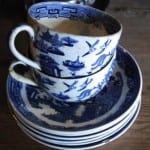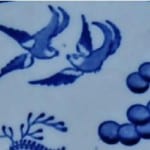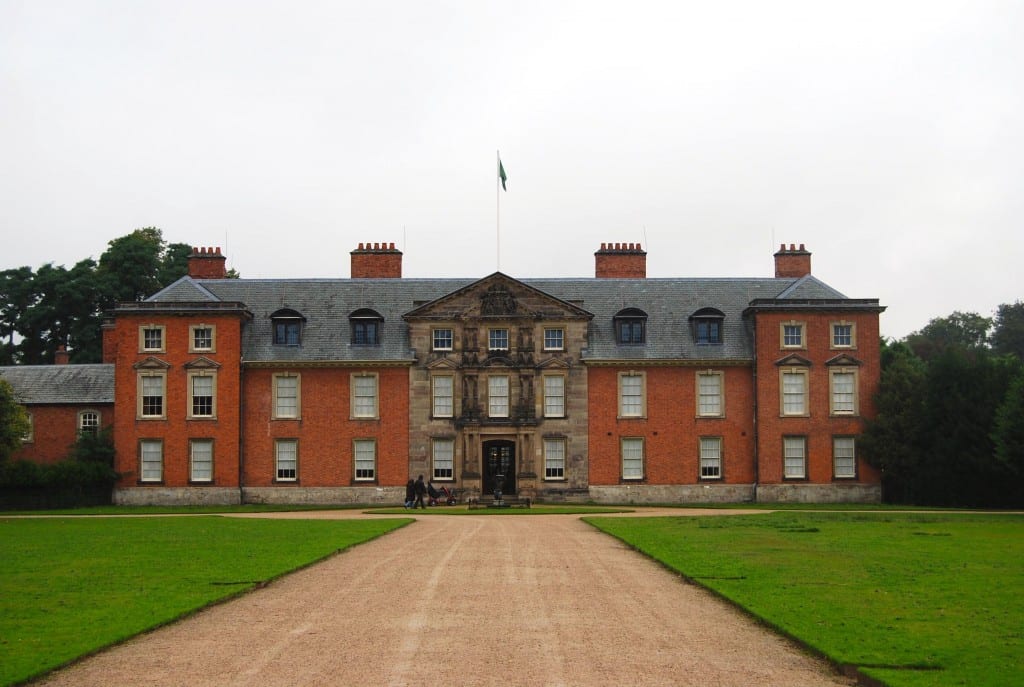The Willow Pattern: Dunham Massey
By Francesca D’Antonio
Please note that this case study was first published on blogs.ucl.ac.uk/eicah in June 2014. The case study was last checked by the project team on 19 August 2014.
For citation advice, visit ‘Using the website’.
Unlike other ‘objects studies’ featured in the East India Company At Home 1757-1857 project, this case study will focus on a specific ceramic ware pattern rather than a particular item associated with the East India Company (EIC). With particular attention to the contents of Dunham Massey, Greater Manchester, I focus here on the Willow Pattern, a type of blue and white ‘Chinese style’ design, which was created in 1790 at the Caughley Factory in Shropshire. The large-scale production of ceramic wares featuring the same design became possible only in the late eighteenth century after John Sadler and Guy Green patented their method of transfer printing for commercial use in 1756. Willow Pattern wares became increasingly popular in the early nineteenth century, allowing large groups of people access to this design. Despite imitating Chinese wares so that they recalled Chinese hard-stone porcelain body and cobalt blue decorations, these wares remained distinct from them, often attracting lower values and esteem. Although unfashionable now, they should not be merely dismissed as poor imitations by contemporary scholars, but rather need to be recognized for their complexities. To explore and reveal the contradictions and intricacies held within Willow Pattern wares, this case study asks two simple questions. First, what did Willow Pattern wares mean in nineteenth-century Britain? Second, did EIC families—who, as a group, enjoyed privileged access to Chinese porcelain—engage with these imitative wares and if so, how, why and what might their interactions reveal about the household objects?
As other scholars have shown, EIC officials’ cultural understandings of China often developed from engagements with the materials they imported, as well as discussions of and visits to China. These encounters set them apart from other British consumers who often had no first-hand knowledge of Chinese culture. Families with connections to the EIC, I suggest, were well placed to develop particular understandings of the aesthetics that defined Chinese objects. During the early eighteenth century, export wares were privileged items that attracted high prices. Imagery, colour, materials, size and standards of execution set these wares apart from the early imitations created by porcelain and earthenware manufacturers in eighteenth-century Europe. Even in the late eighteenth century, lower-end goods such as Willow Pattern ware, with its soft-paste porcelain body, transfer printed decoration and locally designed imagery, existed in clear contrast with ceramics produced in China. Nevertheless, despite often possessing a particular understanding of the nuances of Chinese aesthetics and Chinese objects and in spite of easy access to Asian wares, EIC families purchased Willow Pattern plates, bowls, cups and tableware. Why did they choose to do so?
Numerous estates with historic links to the EIC have Willow Pattern wares in their extant collections, but it was Dunham Massey in Greater Manchester that intrigued me, mainly because of the breadth of Willow Pattern wares in its current collection. My first aim was to uncover whether these same wares (or others like them) were present at Dunham Massey during the nineteenth century when Company families also lived there, and second, how these items compare to other Willow Pattern wares of the period. I have also been keen to establish the role that Willow Pattern wares might have played within the Cheshire-based family home. Were they acquired for both utilitarian and ornamental use? On what occasions did the family use them and where were they displayed? What meanings did they hold for families with global connections? Were they all of the standard design or were variations appreciated? In exploring these questions, this case study hopes to broaden the scope of the East India Company At Home 1757-1857 project by focusing on forms of Asian-inspired but British-produced objects with which Company families engaged. During my research first-hand observations of Dunham Massey’s Willow Pattern collection, studying the estate’s inventories at the John Rylands Library in Manchester and discussions with Dunham Massey House and Collections Manager Katie Taylor, have brought to light an array of pertinent material. My research, however, did not lead me to conclusive findings on all these questions. I therefore invite readers to use this case study as a springboard and a preliminary report on research in development.
My difficulty in reaching conclusive findings regarding Willow Pattern wares primarily occurred due to the frequency of omissions and absences in the written historical record. Extant objects confirm the ubiquitous presence of Willow Pattern wares and their cultural importance to nineteenth-century British society. Nevertheless their specific role within homes, and particularly within EIC related homes such as Dunham Massey, is still to be fully understood. I have examined a series of inventories of the Dunham Massey estate (1819, 1883, 1905 and 1912) that correspond to the period in which the Willow Pattern emerged on the market and gained its popularity. However, the term ‘Willow Pattern’ does not appear in these documents. Although it was not common practice to identify wares under names such as ‘imari’, ‘ding’, ‘famille rose’ or ‘celadon’ as would be done today, detailed descriptions of wares are included in Dunham Massey’s nineteenth-century inventories. For example, the 1912 inventory lists ‘a pair of very fine old powdered blue nankin jars and covers, each with four large views and several smaller compartments of figures, flowers etc. Two dog handles and two circular turned mahogany stand on feet for (40 inches)’.[1] None of the detailed descriptions in the inventories, however, lists Willow Pattern features. Perhaps the pattern’s familiarity, accessibility, and mass production made it irrelevant for documents of this nature, which instead focused on items deemed precious and valuable. Within the course of this case study it will become evident that the Willow Pattern’s apparent absence in the inventories of Dunham Massey’s inventory speaks to a broader trend. Despite its conspicuous presence in nineteenth-century England, Willow Pattern made little impact on the historical record. It is rarely listed in inventories and other historical sources. At times, however, the strict omission of Willow Pattern characteristics in documentation is telling – possibly reminding us of the everyday nature of this Asian-inspired ware.
 The Willow Pattern explained
The Willow Pattern explained
While the original 1790 Willow Pattern can be understood as an attempt by British manufacturers to fabricate an idyllic far-away place, loosely understood as Chinese, it was the later patterns and developments that marked its success. For instance, the tragic love narrative, which is now understood as an important part of the Willow Pattern, was a much later innovation.
 Visit to Dunham Massey
Visit to Dunham Massey
Francesca D’Antonio visited Dunham Massey on 10 September 2013 and met with the House and Collections Katie Taylor. While seeing Dunham Massey’s Willow Pattern ware collection, and particularly seeing it at the house, was important it also revealed the problems and challenges presented by engaging with objects to further historical research.
 Inventories
Inventories
Inventories are important sources for scholars wishing to track movable goods within domestic spaces. Nevertheless inventories prove problematic when researching goods of lower status and value such as Willow Pattern wares. Seemingly absent from the historical record, descriptive phrases remain the only clues to their presence.
 Conclusion and bibliography
Conclusion and bibliography
The difficult path of following these wares into the past through inventories has demonstrated the silence of these prosaic forms in the historical record. Nonetheless through its reading this case study has tried to reconstruct their presence in order to suggest that alongside armorial wares, export objects, and bespoke gilded furniture, East India Company families also engaged with home-grown chinoiserie.
To read the case study as a PDF, click here.
Acknowledgements
The text and research for ‘The Willow Pattern: Dunham Massey’ were primarily authored by project associate Francesca D’Antonio.
[1]Samuel Taylor, Inventory of Contents with Heirlooms of Dunham Massey Hall, Cheshire (Altrincham: n.p. 1912), p. 97.
